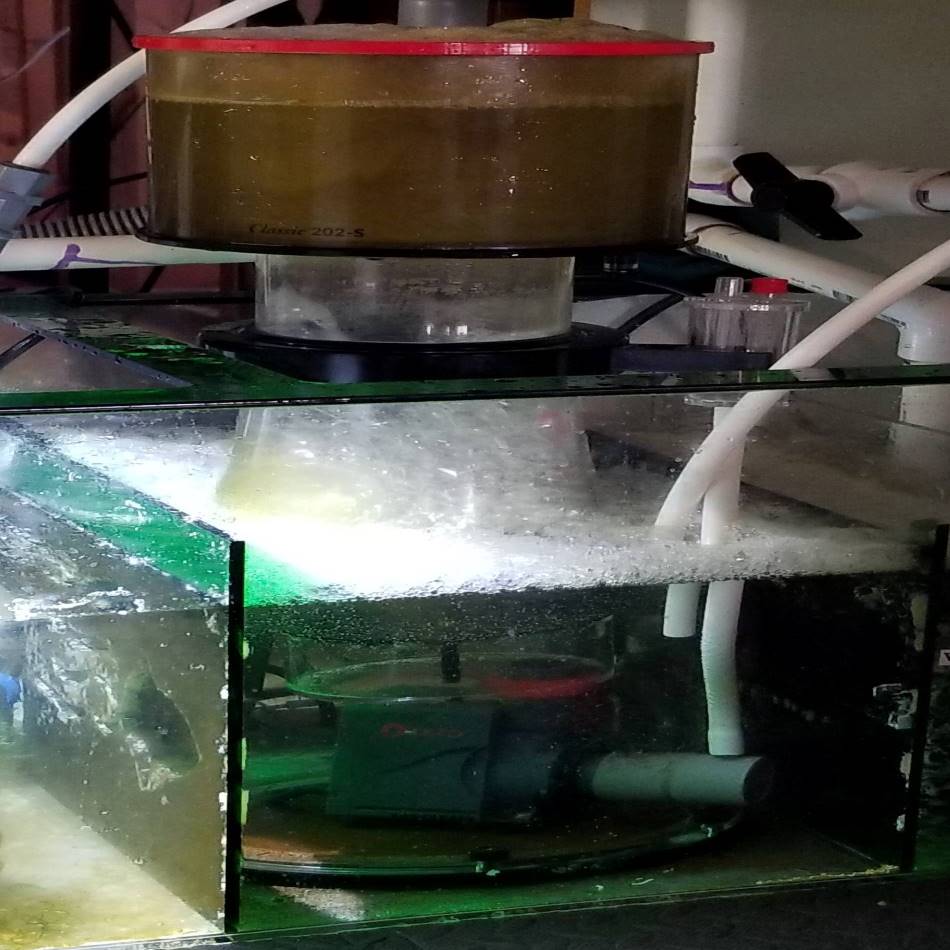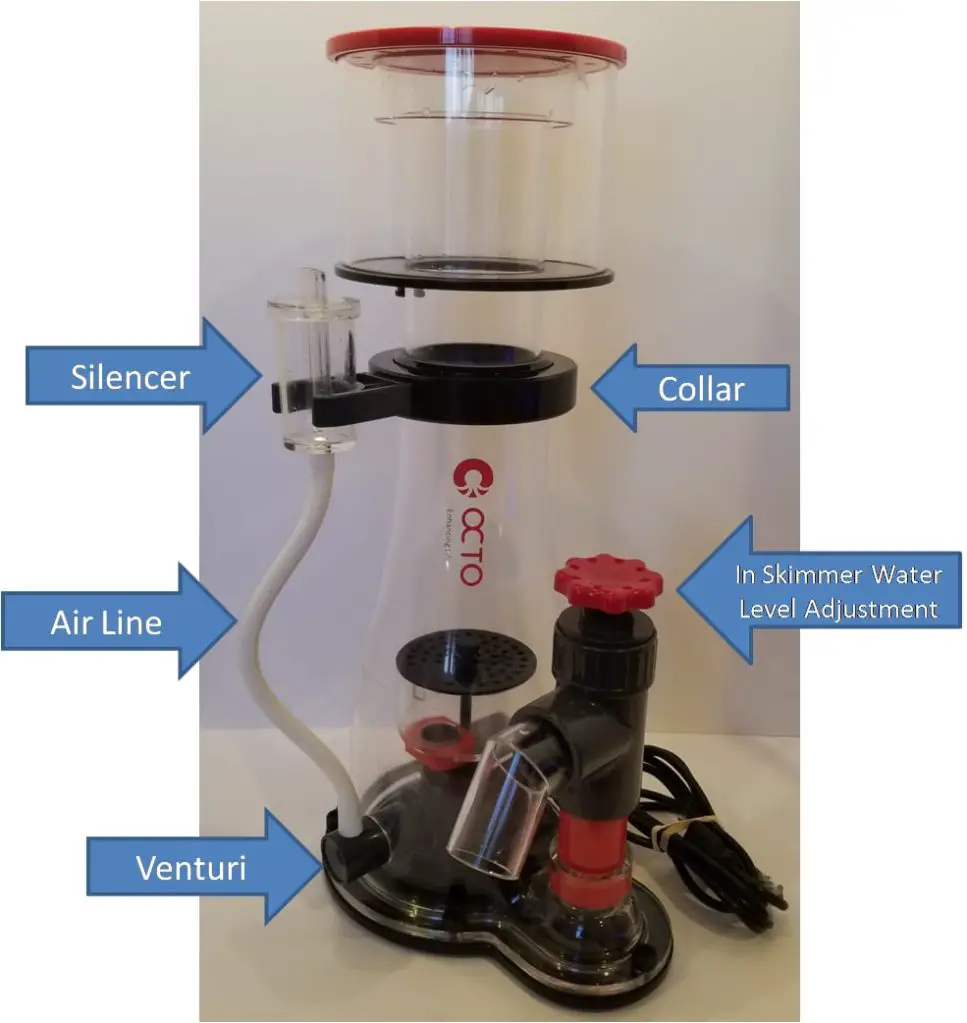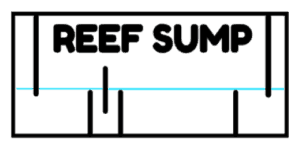
In the saltwater aquarium, hobby protein skimmers are awesome pieces of equipment that do a wonderful job of filtering out waste in the water column.
Protein skimmers are one of the few pieces of equipment that directly export waste out of the aquarium’s water column. Protein skimmers work by mixing air and water to create thousands of microbubbles inside the skimmer’s body. These microbubbles each have a surface area that attaches to dissolved organic waste in the aquarium’s water. As the attachment between waste and bubbles happens, foam is produced that is pushed up the body of the skimmer and out of the water via a collection cup. A good protein skimmer will produce a dark foul waste called skimmate. Removing skimmate from the water helps reduce nitrate and phosphate build-up in a tank.
As the process of skimming is happening one of the more common issues with protein skimmers is sending too much foam or water up through the body and into the collection cup eventually leading to an overflow. The overflow can be skimmate and foam released back into the water or no skimming happening as water just continuously overflow back into the sump. Skimming is usually a slower process with only a small amount of waste moving into the collection cup at any point in time. On my heavily stocked 210-gallon reef tank with a Reef Octopus Classic 202-S skimmer, I normally empty the collection cup every 2 weeks or so. When too much water or foam is produced, the collection cup overflows and empties into the sump. This can be a maddening issue especially if it is variable and nasty skimmate gets emptied back into the water column with the overflow.
So if your protein skimmer is constantly overflowing how do you stop it? To stop a protein skimmer from overflowing you will need to identify the root cause of the issue and take specific action steps to fix the issue.
Root causes include chemical reactions in the water, water levels in the sump and skimmer, the skimmer will need breaking in, and the air intake line might be clogged. Fixing these root causes include fixing water chemistry, adjusting water levels, breaking the skimmer in, and unclogging the air intake line.
This article will go into the specifics of each root cause and how to fix them. Read on to find the right solution if you’re facing the maddening issue of a protein skimmer constantly overflowing.
Reasons why Protein Skimmers Overflow
The first step in fixing protein overflow issues is to identify the root cause or causes of the issue. Root causes of overflow include the protein skimmer needing to be broken in, a chemical reaction happening in the water, the water level of the sump, the water level in the skimmer, and blockage in the air intake line. First, go through each of these root causes trying to rule out each one. If you can’t rule it out take the necessary action steps per each root cause to fix overflowing.
Protein Skimmer Overflows Due to Needing to be Broken in
Protein skimmers are made of plastic and metal pieces. In the manufacturing process of skimmers, chemicals and oils are used to mold the pieces. This residue often stays on the equipment as it reaches the consumer’s hands.
This is usually not an issue to the overall health of a tank, but it can cause the skimmer to overflow. Remember that a skimmer’s job is to remove unwanted things from the water column and these manufacturing residues can cause the skimmer to overflow. So if your skimmer is relatively new, you may need to break in your protein skimmer before it will stop overflowing.
How to Break in Your Skimmer
Breaking in your protein skimmer is usually best done by following the manufacturing directions and making micro-adjustments over time to dial the skimmer into where it is skimming efficiently based on your systems setup. I’ve seen a lot of variation in out-of-the-box protein skimmers from working perfectly and creating skimmate immediately to taking up to two weeks for a skimmer to be fully dialed in. Out the box performance will rely heavily on the skimmer itself and the system it is being put in.
Another thing you can try is to remove the manufacturing chemicals before putting the skimmer in service on your aquarium. An easy way to do this is by running the skimmer in a bucket or container with some water and vinegar for a couple of hours. Place the skimmer in a container and add some vinegar, I usually use about 1 cup. Then fill the bucket with water up to the recommended water line of the skimmer.
Run the skimmer for about an hour, shut it off, then remove it from the bucket. Rinse the skimmer and pump thoroughly before installing it on your tank. Below is another article I wrote going into even more detail on breaking in a new skimmer.
Protein Skimmer is Overflowing Due to a Chemical Reaction
Chemical reactions in the aquarium’s water are one of the most common root causes of an overflowing skimmer. Anytime anything is added to the water in the reef tank the composition of the water changes. A change in composition, it may cause the skimmer to overflow as it works to remove the additive to the tank. Just about anything added to the water or aquarium can cause overflow issues. Here are some of the most common culprits:
New or freshly washed filter socks: If your filter socks are new they may have some residue left on them from the manufacturing process. If the sock or freshly washed they may have some residue from the washing machine or other washing process that you used.
The Best and Easiest Way to Clean Aquarium Filter Socks Plus Other Methods
Feeding: Some foods have high dissolved protein oils in them that in high doses can cause the skimmer to overflow. I’ve seen this happen with some frozen foods.
Chemical Dosing: Using any treatment medications, buffers, or other supplements usually will cause the skimmer to overflow. Many manufacturers of these treatments recommend turning the skimmer off for a while to allow the supplement to work before being removed by the skimmer.
One of the most common products that cause overflow is epoxy putty. Epoxy putty is used to attach rock work or to mount plugs.
Freshly mixed salt: Even a fresh mixed batch of salt during water change can cause overflowing.
How to Fix Overflow Caused by Chemical Reactions
To fix overflow by chemical reactions you’ll want to first determine what changed from one point to another that may have caused a chemical reaction in the tank’s water. Are you dosing, did you put a new filter sock on, did you switch foods, or did you make any other changes listed above? If you can pinpoint the issue then take action:
New or freshly washed filter socks: To prevent overflow from filter socks you’ll want to thoroughly rinse the socks in freshwater before placing them on the system. If you are experiencing overflow with a freshly washed sock, you may want to look at your sock washing process. I wash my filter socks in my home washing machine and use only hot water and haven’t had a skimmer overflow issue.
Feeding: If feeding is causing overflow you may need to switch foods to higher quality or turn the skimmer off during feeding.
Chemical Dosing: This will depend on the dosing that you are doing. The first step is to make sure you are following the directions of the product you are using. Many of these products will have you turn off the skimmer for a while. If this continues, you may need to let the skimmer do its job. First, adjust the internal skimmer water level lower than where it typically runs just so that a small amount of overflow is happening.
Then continuously empty the collection cup until the skimmer stops freaking out. You’ll want to have fresh saltwater available if this process results in a lot of water being taken out of the system. If it is a minimal amount compared to the size of the tank a freshwater top-off might be ok too.
If continuously emptying the collection cup is too laborious you can also do large volume water changes and run carbon in the system to get any chemicals/supplements out of the water column.
Freshly mixed salt: Use the same method as chemical dosing.
Switching from Instant Ocean Reef Crystals to LiveAquaria Professional Reef Salt
Protein Skimmer Overflows Due to the Water Level in the Sump
Protein skimmers can be very sensitive to water levels. The water level in a sump can be a root cause of overflowing. Most skimmers have a recommended water level height in the 7-9” range. Exceeding this range can cause overflowing issues. Most sumps are designed to maintain a certain water level constantly and some sumps even have gates that can be adjusted to change the height of the water level in the skimmer chamber.
How to Fix Overflow Caused by the Water Level in the Sump
For this situation, you want to keep the water level in the skimmer chamber as consistent as possible all of the time. Having an automatic top-off or ATO is one of the best ways to do this. As evaporation happens ATOs will sense this and replenish it with fresh water continuously. The Tunze Osmolator Auto Top Off System is a tried and true ATO in the reef hobby.
Protein Skimmer Overflows Due to the Water Level in the Skimmer Body
Most protein skimmers have a function on them that allows the water level inside of the skimmer to be adjusted. Some skimmers like my Reef Octopus Classic 202-S skimmer use a high-quality gate valve for this function. If the water level is set high on the skimmer and something happens like a sump water level change or a chemical reaction the skimmer will overflow.
How to Fix Overflow Caused by the Water Level in the Skimmer Body
Make sure to set the inner water level of your skimmer to the appropriate height. A good rule of thumb is to set the bubble line to the collar of the skimmer where the collection cup and skimmer meet. Going higher is considered a “wet skim” and any slight change in the water could go from wet skim to overflow. Different skimmers will have different recommendations on where to set the bubble line so make sure to check the instructions for your model of skimmer.
Protein Skimmer Overflows Due to Blockage in Air Intake Line

Most skimmers work off a Venturi where the air is pulled in from the environment and mixed with water to create microbubbles. If air is impeded from entering the skimmer more water than air gets mixed and sent up the skimmer body causing an overflow. You can see this by pinching the airline and seeing the water level in the skimmer rise quickly. In many skimmers, there is an airline that connects to the pump and a silencer on the outside of the skimmer. If any of these components are blocked it could be a root cause of overflow.
How to Fix Overflow Caused by Blockage in Air Intake Line
For this root cause carefully inspect the silencer, airline, and connection at the pump. One of the more common issues you may find is salt creep blocking the silencer or built-up in the airline. Remove the blockage by manually cleaning these items. The airline is usually soft tubing and can sometimes become kinked or pinched. If this is the case un-kink the line or replace it. Lastly, make sure the connection at the return pump is tight.
Fixing skimmer overflow issues will boil down to setting your skimmer up correctly and once correct identifying any underlying root causes for overflow issues. Once you uncovered the likely root cause addressing it specifically will keep your overflow issues to a minimum.

Related Questions
What is a DC-powered protein skimmer?
A DC-powered protein skimmer is a newer type of skimmer pump that is powered by direct current versus the normal alternate current or AC. When you plugin and run an AC skimmer pump it runs at 100% full power. With a DC skimmer pump, you can adjust the amount of power utilized by the pump. This allows for more controllability with the pump and the potential for less power utilization. By ramping the power down on the pump you can easily adjust the bubble line inside the skimmer from the unit’s controller and with sum skimmers, through an app.
Reef Octopus OCTO Regal 150-INT in-Sump Protein Skimmer
The new and innovative Reef Octopus OCTO Regal 150-INT In-Sump Protein Skimmer supplies powerful filtration for aquariums up to 210 gallons where sump space is not limited.
What is a protein skimmer automatic neck cleaner (ANC)?
As your protein skimmer sends microbubbles and dissolved organic compounds up the skimmer’s body waste build-up can occur on the inside of the neck of the protein skimmer. When this happens skimming efficiency can go down. An automatic neck cleaner helps remove this build-up potentially allowing for a reduction in the need to remove and manually clean the skimmer. These devices sit inside the skimmer neck and rotate soft plastic in a circle to squeegee off build-up before it becomes an issue. Reef Octopus Automatic Neck Cleaner
Reef Octopus Automatic Neck Cleaner 250
Octopus motorized (ANC) Automated Neck Cleaner helps keeps your octopus protein skimmer running at peak performance by periodically wiping the inside of the neck where all the bio-organics usually would accumulate.


